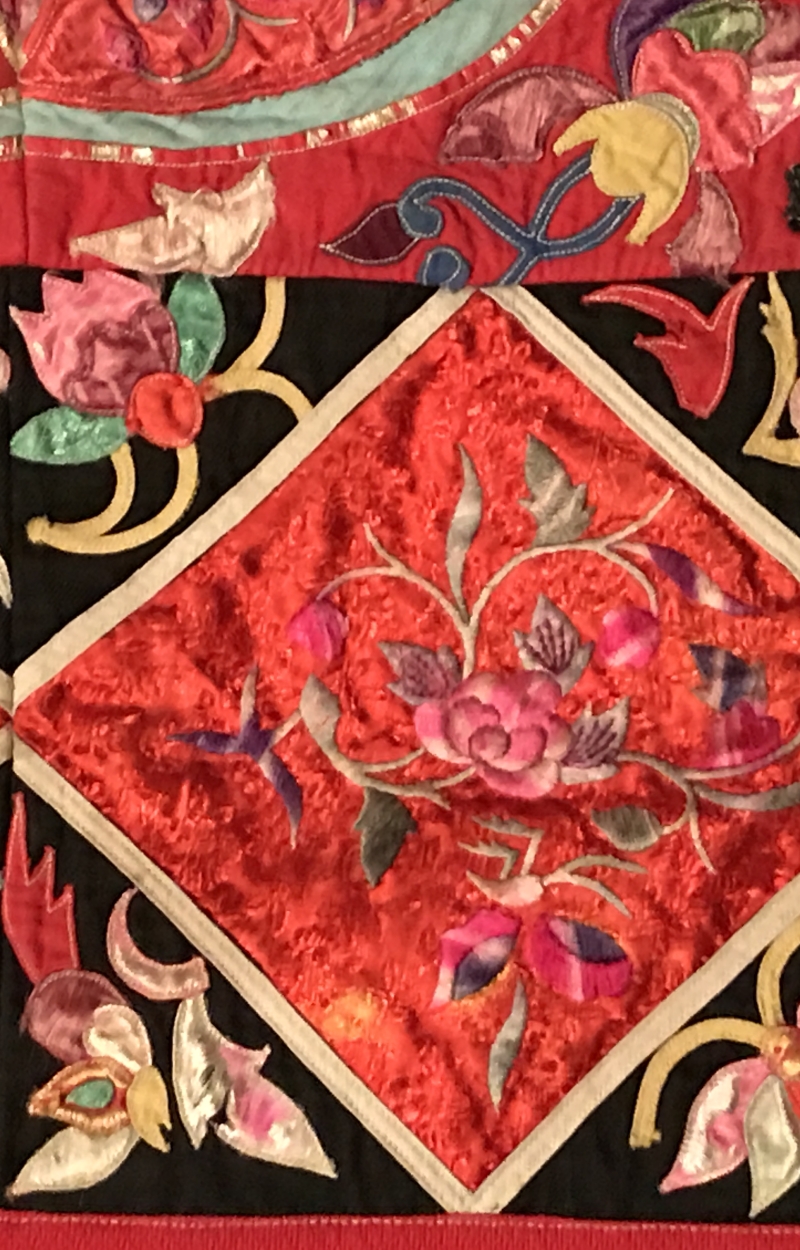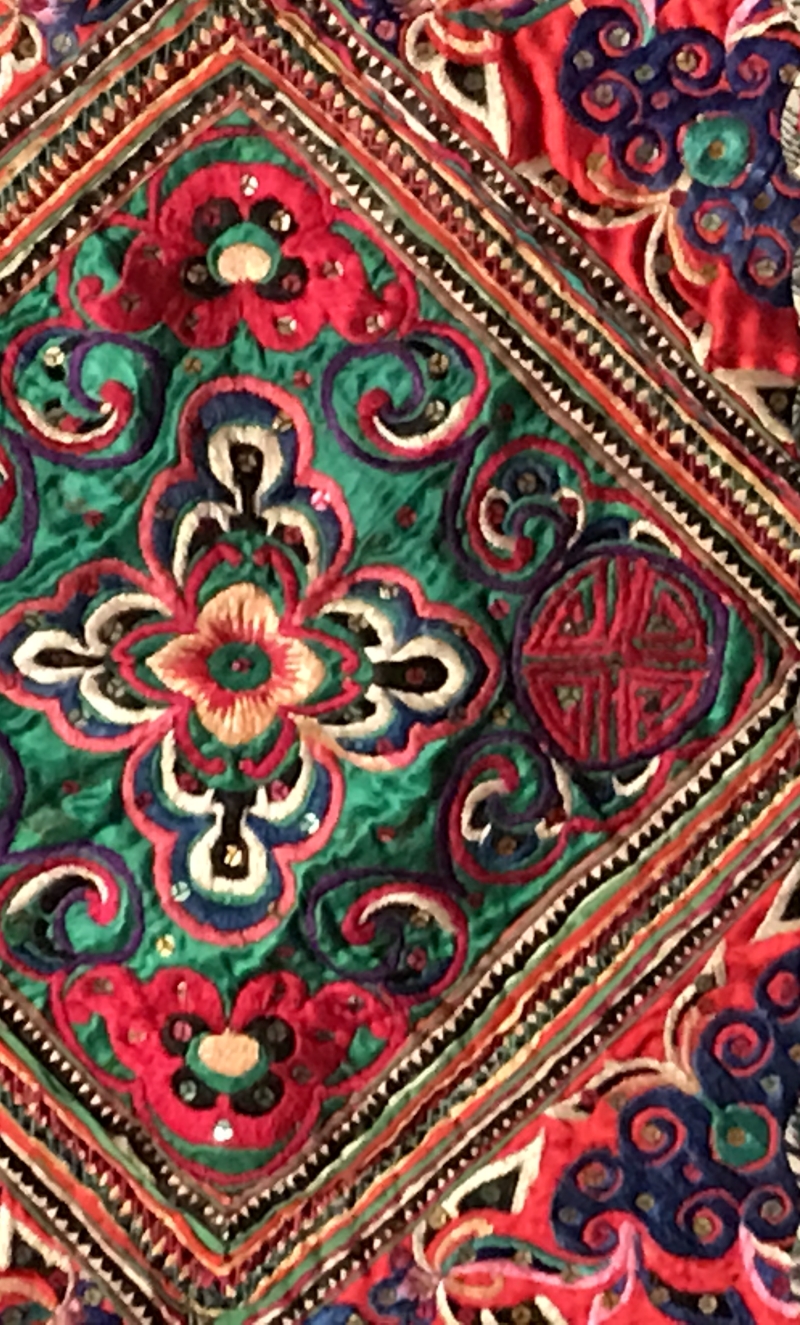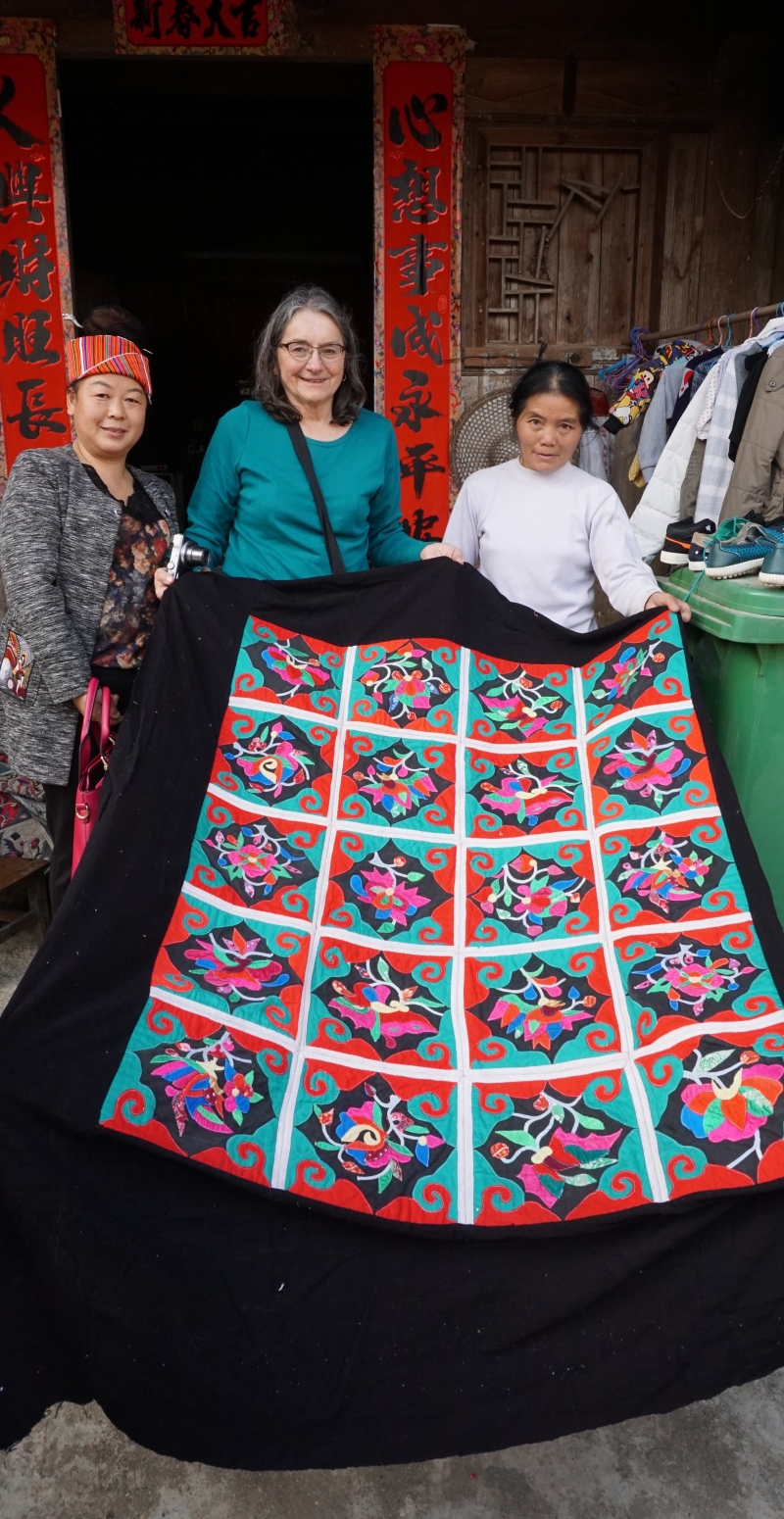Quilts of Southwest China
Photography: Courtesy of Collector Pam Najdowski
I dreamed there was an enormous web of beautiful fabric stretched out … covered all over with embroidered pictures. The pictures were illustrations of the myths of mankind but they were not just pictures, they were the myths themselves, so that the soft fabric was glittering and alive … time has gone and the whole history of man … is present in what I see now … the bright different colors of other parts of the world.
Doris Lessing The Golden Notebook
By Stephanie M. Chambers
Weaving, Quilting, and Embellishment as Non-Verbal Communication
Steve Chambers, Dallas residential architect, visited the Southwest China quilt exhibit at the Museum of International Folk Art (MoIFA) in Santa Fe to photograph the collection and interview Pam Najdowski, textile consultant and part of the acquisition team. Chambers Architects employs ethnographic textiles and objects of art in their interior design, so this was an excellent opportunity to learn about the techniques of quilt construction and standards the team used to select the top designs in this genre.
Weaving is acknowledged to be one of the oldest surviving crafts in the world and traces back to Neolithic times, about 12,000 years ago. Before the actual craft of weaving was highly developed, the basic principle of interlacing was employed to fashion branches and twigs into fences, shelters, and baskets for protection and utility.
Weaving and quilting, with the eventual addition of appliqué and embroidery, expressed the identity of the textile maker and commitment to and membership in a specific community. Women and men told stories through esoteric designs that encoded their vision of the world. The work of textile makers was essential for the survival of important elements of ancient culture. Stories of events, suffering, and oppression could hide between the ‘warp and weft,’ when writings were destroyed to subjugate the culture.
The choice of color, motif, embellishment, and process identify the craftsman and the tribe. The symbolism, developed in the culture over time, was a form of visual or pre-written storytelling that communicated the folklore, beliefs, history, politics, status, kinship and messaging. Creative symbolism through abstraction is a characteristic of all arts and crafts.
Quilts at the Museum of International Folk Art, Santa Fe
Quilts of Southwest China opened at the Museum of International Folk Art (MoIFA) in Santa Fe in July 2017. It is the culmination of a three-year collaboration between three museums in the United States and three in China, spearheaded by the American and Chinese folklore societies and funded by the Henry Luce Foundation. Pam Najdowski, who owns the import company Textile Treasures, was a consultant for the project and helped to acquire many of the quilts on display. Chinese quilts have received little attention from scholars, collectors, or museums. The show is geared toward introducing the varied Chinese quilting traditions of Minority Peoples. Many quilts are from the collection at the Michigan State University Museum. Other pieces come from the Chinese museums and some are from MoIFA’s collection. The Quilts of the Southwest China show primarily includes the work of the Miao, Yao, Zhuang, Bouyei, Dai, Hui, and Maonan ethnic groups listed among the top twenty of the 56 minority people documented in the middle of the 20th century by the PRC.
Most of the quilts and textiles in the show are from the 20th century, but an area of the exhibit is dedicated to 21st-century quilts. As ethnic minority groups become exotic to China, a trend similar to the revival of Do-It-Yourself arts and crafts like knitting and quilting in the United States has popularized the fashion of ethnic minority groups throughout China.
Scholars, cultural practitioners, and local artists are beginning to document the art of quilt making. Museums can play a significant role to develop strategies to preserve the remaining historical textiles and the knowledge and skills of artists so that the tradition of making can continue and be passed down to future generations.
Who are the Minority Peoples of China?
Numbering over 1.3 billion, the Han Chinese are the world’s largest ethnic group and China’s largest native group. Ethnic minorities in China are the non-Han Chinese in the People’s Republic of China (PRC). China officially recognizes 56 ethnic minority groups, in addition to the Han majority. Though the Hans comprise 91% of the population, the smaller groups of Minority People are growing fast.
In mountainous terrain and isolated rural communities of Southwest China women practiced the craft of quilting well into the 20th century, making blankets, bedcovers, and baby slings. In these villages, traditional bed coverings, clothing, and household items have long been made from patched and appliqued scraps to create artistic and functional textiles. Populated by many ethnic minority groups, the countryside became easier to access as modernization took hold after the Communist government gained power in 1949, with the building of roads and factories. It also became more convenient for local people to buy mass-produced goods, and though the quilting tradition faded, it did not disappear. Women continued to make small, lovingly embellished baby carriers and small quilts for friends and family. The government’s new emphasis on preserving the cultural heritage of these groups has given life to their tourist economy of which these quilts have become an integral product.
What is the difference between ethnographic art and folk art?
Ethnographic arts are artifacts, either utilitarian or aesthetic objects, over seventy-five years old. Folk arts are the traditions, whose use extended into current day arts and crafts. Many of the quilted pieces in the MoIFA Santa Fe show would be considered duvet covers in the American textile tradition, but like American quilts they are made from scraps of old clothing and other fabric. Chinese quilts are riotous with color, and the designs within the quilted squares contain many uneven thin and curving lines, whereas traditional American quilting is much more geometric and symmetrical.
Chinese minority quilts utilize symbols of protection, good fortune, fertility, or sometimes depict a folk tale or visual pun. Sea creatures, butterflies, and other flora and fauna populate the quilts. Imagery can be religious, with Buddhist, Islamic, or Christian symbolism, as well as iconography from many smaller faith traditions practiced by individual groups. Ethnic groups can be identified by their use of certain motifs, colors, or themes. Researchers are seeking information about whether techniques, colors, patterns, materials, and design motifs indicate a specific ethnic group or village aesthetic, what makes a beautiful quilt and who determines that standard, and whether the fabric or pattern can be used to determine the age of the quilt. A recurring element in the quilts is the resistance to symmetry. Often a pattern may appear uniform, but a closer look will reveal disruption in one corner with an unexpected color or a broken line.
Future of the Project
In the project’s first three years, researchers learned how to work with each other across cultures as well as across different informational and technological platforms. Another three-year grant has been secured and the project’s next steps will focus more intently in two communities in Guangxi Province.
Consultant and Adviser
Thank you to Pam Najdowski for her deep knowledge of the ethnic arts, culture, and geography of China’s Minority People. She owns the import company Textile Treasures and acquired many of the quilts for the Santa Fe MoIFA show. Pam lives in Santa Fe and has a booth at The Traveler’s Market at the DeVargas Center, where ethnographic and folk arts of Minority Peoples of China can be acquired.
Terms:
Appliqué: the technique of layering down a series of small pieces of cut fabric to create a shape or image and fixed atop a solid bottom fabric with embroidery.
Embroidery: art of fabricating raised and ornamental designs in threads of silk, cotton, gold, silver, or other material, upon any woven fabric, leather, or paper with a needle.
Indigo dye: referred to as blue gold, indigo is a natural dye extracted from the leaves of the plant, genus Indigofera, the blue for denim fabrics.















